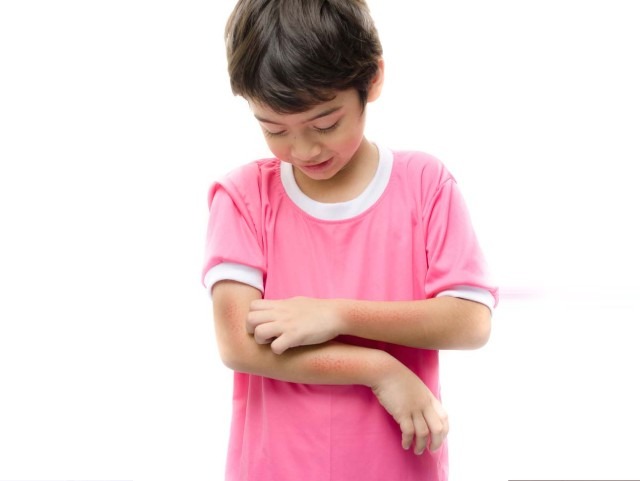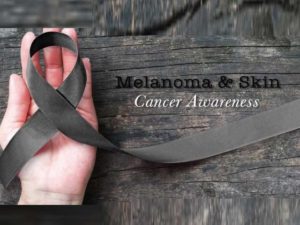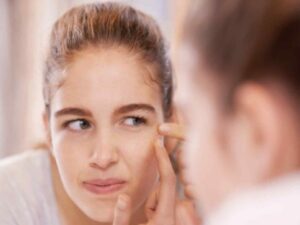Upto 20% of all children suffer from “the itch that rashes”. Eczema can be particularly frustrating because there is no cure and multiple triggers can set off that nasty itch. Here’s how parents can cope..
Who develops Eczema?
“Eczema” is a broad term that encompasses a wide range of skin rashes that leave the skin red, itchy, oozy, scaly and irritated. About 65% of kids with eczema have developed the problem by age 1, and 90% of kids affected by eczema develop the symptoms before their 5th birthday.
What does Eczema look like?
In infancy, eczema appears as red dry scaly rash on the head, scalp, neck and diaper area, with perhaps a few scattered rashes over the back or abdomen.
As the child grows and begins to crawl, the rashes begin appearing over the forearms and shins. In the early days, the rash is red and moist. As the days progress, it turns pink and scaly.
During the toddler and pre-teen years, the rash is generally worst on the body folds – like the inside of the elbows, the armpits and the back of the knees. In severe cases, the rash may spread to involve large parts of the body. As the child continues to itch for weeks or months, the skin turns dark, thick and lined, like the bark of a tree.
During the teen years, most children begin to outgrow their eczema. However, some may continue to have flare ups during winters or periods of emotional distress. Some may continue to have dry itchy rashes on their hands for several years, along with a general tendency for skin sensitivity.
What puts my child at higher risk for Eczema?
Eczema often runs in the family. “Atopy” is a condition of increased risk for skin, respiratory and eye allergies. Most kids with Eczema come from families with “atopic individuals”. This means, people in this family have a tendency for Eczema, Asthma, Hay Fever and allergic eye itching. In fact, a lot of kids who suffer from Eczema may also have Asthma or Hay Fever.
What triggers Eczema?
The main problem with this condition is itching. This is why Eczema is known as the “itch that rashes” rather than the rash that itches. An itch leads to scratching. Scratching leads to the appearance of rash. The rashes make the skin itchier. This leads to the vicious itch-scratch-itch cycle.
Potentially everything under the sun, including the sun, can cause your child’s skin to itch!
Dryness of the skin in winter can lead to itching.
Prickly heat in summer can lead to itching.
These children are particularly sensitive to mosquito bites, artificial jewellery and fragranced cosmetics/toiletries.
Some of these children may be sensitive to their own sweat, and excessive sweating itself can lead to itching and rash.
Rough clothing like wool and denim can irritate the skin. Clothes washed in harsh laundry detergent can also irritate the skin.
Children with eczema are particularly prone to developing skin infections. This is because healthy skin forms a natural barrier against the entry of germs and infection. But eczematous skin is weak and broken and cannot resist pathogenic invasion. Certain skin infections like herpes, fungal rash and Scabies are naturally itchy. The itching induced by these infections can also flare up your child’s Eczema.
Food allergens have also found to play a role. Dairy, poultry, gluten, seafood, soy and nuts are amongst the most common culprits. Staying away from the offending food can keep the itch under control. However, parents may find it hard to identify food allergies if the child is allergic to multiple food items, or itchy on a daily basis due to other irritants like soap or fabric.
Your child’s skin might also be sensitive to dust, pollen, mold, animal hair and smoke (from tobacco or burning wood).
Stress and emotional distress do not cause Eczema, but can definitely worsen it. A caretaker (like a beloved grandparent) moving away, first day at school, a strict parent/teacher or exam woes – parents will notice a link between emotional distress and itch. Older children might even itch to seek attention.
Is Eczema is a modern-day disease?
Eczemas have always existed but modernization has definitely led to an increase in all kinds of allergy. Breastfeeding has been found to protect children from eczema. Over-sanitization, indiscriminate use of vaccines and antibiotics, and living in air-conditioned and carpeted homes and offices have played a role in the increasing incidence of allergies.
Playing in the mud, having a pet from a young age, and the occasional intestinal worm infestation can help in maturing your child’s immune system.
Are there supplements or herbs that can help?
If your child suffers from dry skin, then oral intake of omega-3 and omega-6 fatty acids can help. Dietary sources include oily fish like cod, egg yolk, olives, almonds, walnuts, tofu and flaxseed.
Some studies have found Vitamin D supplementation to be helpful in combating eczema.
Probiotics have also been prescribed with some benefit. Increasing fish and probiotic intake during pregnancy can protect your child from eczema. Probiotics can be found in fermented food like yoghurt, yeast and sauerkraut. Lactobacillus rhamnosus and Bifidobacteria are most commonly prescribed in Atopic children. Indiscriminate use of probiotics however could leave to bowel dysregulation.
Are there any tests to diagnose Eczema?
There are some basic tests which parents can do from home –
1) Elimination diet tests – Eliminating one food item/group from the diet. For instance, dairy or poultry. It is recommended to eliminate the said food item for at least a week to interpret the results. If the itching subsides, it indicates a possible allergy to that particular food item.
2) Repeat Open Application Test – If your child is allergic to various soaps or moisturizers, this is a useful test to carry out before trying any new cosmetic. Apply the said cream or toiletry, twice a day to the inner elbow for a week. If your child develops redness, rash or itch, he is most likely allergic to the said product.
Consult your Dermatologist or Allergologist regarding clinical blood tests (like the RAST test) or skin tests, namely ‘Prick Testing’ and ‘Patch Testing’. Your doctor will choose the test depending upon your child’s history and symptoms.
How can I manage my child’s eczema?
Protect your child from anything that makes her itch. Skin care and clothing care is the first step towards this goal, and should be treated as a lifestyle modification rather than a temporary fix.
1) Bathe your child not more than once a day with lukewarm water. Give him a quick bath with a mild soap-free cleanser like Cetaphil cleansing lotion. Prefer Syndets over Soaps. Avoid bubble baths , fragranced toiletries, massage oils and long showers. Diluted bleach baths are very helpful if your child suffers from repeated skin infections secondary to the eczema. Pat dry after a bath. Vigorous rubbing can trigger the itch.
2) Use bland moisturizing creams all over the body within minutes of towel-drying. It may take some trial-and-error to find the right emollient. Creams work better than lotions. Seek your dermatologist’s opinion on brands.
3) Protect your child from insect bites.
4) Keep your child’s skin well covered with soft garments. Avoid wool, silks and denim. Avoid fabrics that leech colour. Pre-wash all new clothes and bed linen before use. Do not let your child crawl or sit on carpets and rugs.
5) Use fragrance-free liquid detergents to wash your child’s clothes and bed linen. Make sure to rinse off the detergent thoroughly before use. Using an unscented fabric softener can be helpful.
6) Wet wraps are helpful in soothing itchy skin and can help seal-in the moisture after applying emollients.
7) Keep your child’s nails short and filed. Put mittens on while your child sleeps, to prevent him from scratching.
8) Saliva is a known cause of eczema around the mouth. Avoid using wet wipes. If your baby tends to drool, use petroleum jelly on your baby’s cheeks and chin before meal time and nap time.
9) Skip “herbal” remedies like neem oil, eucalyptus oil and other essential oils like lavender or chamomile. Kids with eczema cannot tolerate several herbal formulations.
10) Treat skin infections promptly without resorting to over-enthusiastic use of oral antibiotics. Prolonged itching from Scabies or a fungal infection can lead to secondary eczema.
11) Dust and pollen is all around us. If your child has tested positive for dust or pollen allergy, then consult an Allergologist for advice on how to reduce dust and pollen in your environment. Simple measures like dust-mite pillow covers, vacuuming, air filters and humidifiers can help.
12) Avoid hand sanitizers. Let your child carry Cetaphil cleansing lotion to school instead. Most schools now avoid carpets and soft toys as a lot of kids suffer from eczema and respiratory allergies. Inform your child’s teachers about any food allergies. Leave some emergency cortisone cream or Cetrizine syrup with the school nurse.
13) If your child needs sunscreen, select a plain Zinc Oxide based sunscreen which is hypoallergenic.
14) Good sleep can help is soothing the symptoms of eczema. However chronic and severe itching can ruin your child’s sleep. Sedative antihistamines like Cetrizine are helpful in providing itch relief and a good night’s sleep. Eczema has been associated with co-morbidities like depression, attention deficit hyperactivity disorder, epilepsy and heart disease. These may be caused by accumulated lack of sleep over the years.
ps: My blogs are not meant as a substitute for a proper medical consultation. Eczema manifests in multiple forms – from Atopic Dermatitis to Pompholyx to Nummular Dermatitis and much more. Each child is unique in his symptoms, clinical presentation, triggers and response to treatment. Consult a good dermatologist for diagnosis and guidance.




